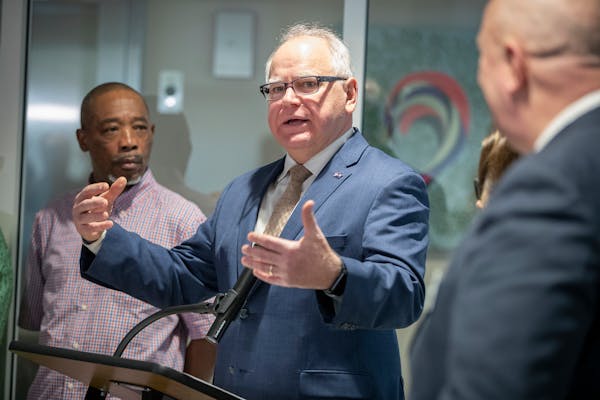Gov. Tim Walz said Friday he wants to spend more than $300 million to replace aging infrastructure and upgrade water treatment facilities across the state.
To underscore the need, Walz donned a yellow hard hat and a safety harness, stepped into a metal basket and was lowered down a 90-foot shaft for a tour of Minneapolis stormwater tunnels.
The $300 million proposal is part of a $2 billion borrowing package Walz is rolling out over several days. The package is expected to be the focus of much of the upcoming legislative session.
After arriving in the cavernous and mostly empty tunnel, the governor learned firsthand what Minneapolis officials deal with when it comes to clearing the streets of stormwater.
The tour was taken at a time of year when the tunnel is generally safe to visit. Spring rains can fill the tunnel to its ceiling, city officials said.
It's a piece of the city that taxpayers rely on but rarely or never see, said Walz. So much of water infrastructure is "out of sight, out of mind," he said.
"There's been generations of investment in infrastructure," he said. "This stuff is 100 years old in many cases. It's not going to get cheaper to do it. We're in a position in the state where we have the capacity to do it, and these are the things that each generation needs to invest in.
"I think that's why it's important to get out here, see these projects firsthand, put that information out to the public so they understand."
Minneapolis officials said some of the aging stormwater tunnel system leaks, creating washed-out areas or voids that destabilize the soil beneath the city. Other tunnels are too small to handle the record-setting rainfalls the city has experienced in recent years, causing high pressure within the tunnels that can pop manhole covers or flood streets.
Walz said he tries to relate the need to typical home repairs. No one likes to fix their roof or replace their windows, but eventually it has to be done, he said.
"Those are investments that bring value back into your house. Same thing with the state: If we don't keep our infrastructure up, it reduces our capacity," Walz said.
The governor said the goal is to help cities, particularly smaller communities in greater Minnesota, with costly upgrades to water systems needed to clean pollutants from their water without causing soaring utility bills.
Walz has said the costs for all of his proposed projects could approach $2 billion, paid for mostly through state borrowing. Republicans have generally opposed spending anywhere near that much.
Sen. Dave Senjem, R-Rochester, who chairs the Senate's Capital Investment Committee, said there are "many projects that are worthy of consideration, but we also need to be responsible for what we borrow. It's not just free money."
Senate Majority Leader Paul Gazelka, R-Nisswa, said he prefers a figure somewhat lower than $1 billion.
"I'm more comfortable with those kinds of numbers than $2 billion," he said.
Asked what he had learned on his tour of a newly repaired tunnel under Hennepin Avenue in southeast Minneapolis, Walz said he saw how a weakness in one part of the stormwater system can undermine the rest.
"The biggest thing is listening to the systemwide strain that's put on them when they don't have the capacity," he said. "The visible result for the citizens is when a manhole cover pops up on the street, but what they're not seeing down here is holes that are creating voids in the soil, potential sinkholes, collapse of these tunnels, more streets close. For me it's pretty interesting to see the interconnectedness of this entire 16-mile system."
Here's the full list:
$25 million for water infrastructure grants and to increase lending capacity in the Clean Water and Drinking Water Revolving Funds.
$100 million for the Water Infrastructure Funding Program, which provides supplemental assistance grants to help communities build clean water and drinking water infrastructure projects.
$75 million for the Point Source Implementation Grants (PSIG) program, which provides grants to help communities build wastewater, storm water, and drinking water treatment projects when the Minnesota Pollution Control Agency (MPCA) determines that higher levels of treatment are necessary to meet water quality goals.
$15 million for grants to municipalities to build sustainable and resilient stormwater infrastructure, with a focus on managing extreme weather events.
$1.2 million for cleanup of groundwater contamination at the Esko superfund site.
$2 million for removal of sediment contaminated by polyaromatic hydrocarbon from stormwater ponds.
$6 million for cleanup of contaminants at the Precision Plating State superfund site.
$5 million for public infrastructure improvements to reduce inflow and infiltration into local and regional wastewater collection systems.
$16.5 million for the Minnesota Conservation Reserve Enhancement Program (CREP) to acquire permanent easements in ecologically sensitive areas, which will help improve water quality and wildlife habitat.
$8.646 million to upgrade, construct, and support a new infrastructure system for the snow making process at Giants Ridge.
$587,000 for a grant to Lake City to extend a water and sewer connection to Hok-Si-La Park.
$12.385 million for riverbank stabilization and erosion control in Mankato.
$4.15 million for restoring wetlands in Mankato.
$19 million for a new tunnel in Minneapolis to reduce the risk of tunnel failure and the potential for sanitary releases into the river.
$10 million for a boardwalk and ecological restoration in Wayzata.

'Safe recovery sites' would offer syringes, naloxone and more to people using drugs. The plan could be in peril.
New Minnesota GOP leaders seek peace with party's anti-establishment wing

Who is Republican Lisa Demuth, Minnesota's first House speaker of color?

